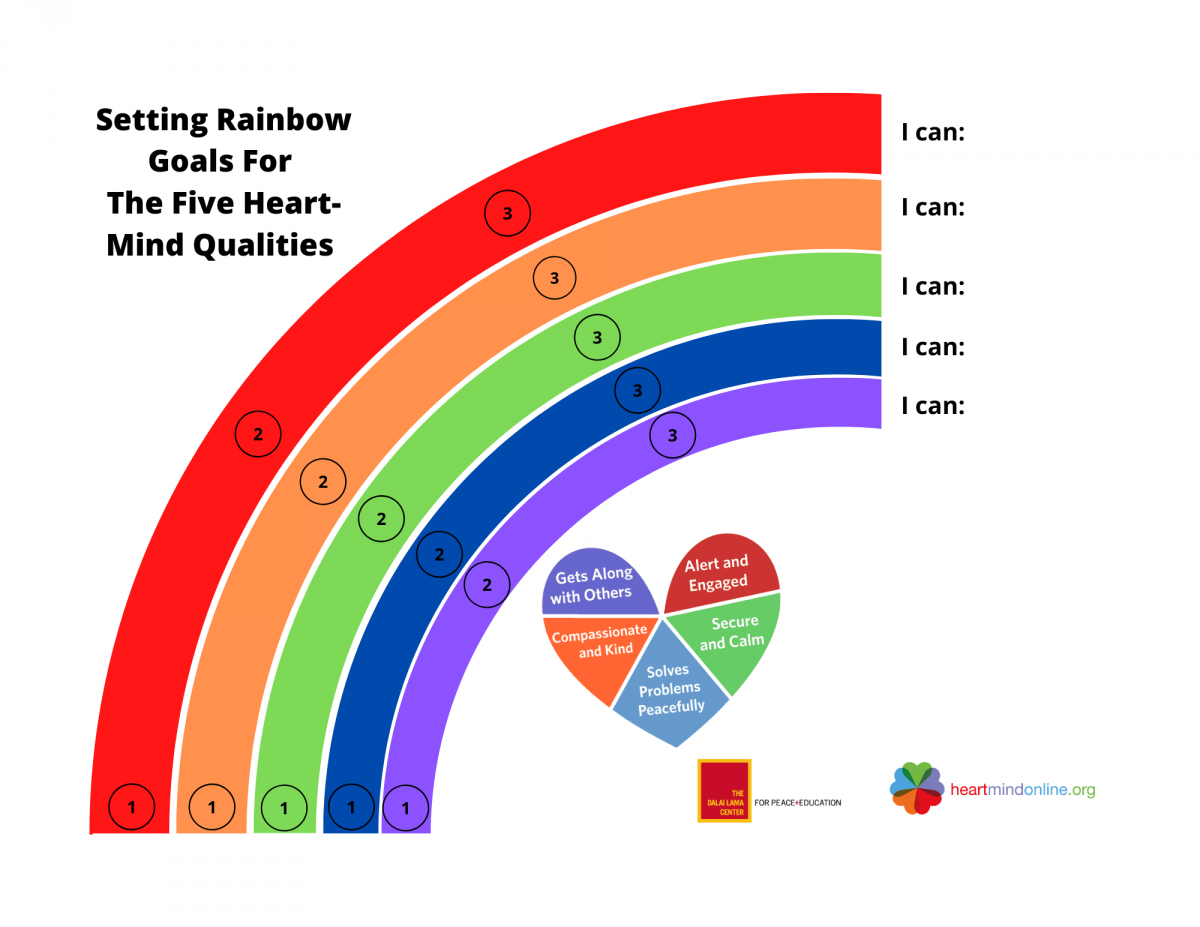 Rainbow Goal Setting is a simple, effective, and inclusive tool to support young people in strengthening the Five Heart-Mind Qualities in ways that are meaningful and accessible to them. It is grounded in proven strategies recommended by inclusive education expert Shelley Moore, such as backwards design, scaffolding complexity, and reinventing "SMART" goals, in order to reach the "outside pins" as well as those falling in between them.
Rainbow Goal Setting is a simple, effective, and inclusive tool to support young people in strengthening the Five Heart-Mind Qualities in ways that are meaningful and accessible to them. It is grounded in proven strategies recommended by inclusive education expert Shelley Moore, such as backwards design, scaffolding complexity, and reinventing "SMART" goals, in order to reach the "outside pins" as well as those falling in between them.
Why do we nurture Heart-Mind Well-being in children and youth? The short answer is because we care about them and want them to succeed.
The long answer is that we do so in order to equip them with essential personal and relationship skills that are linked to improved subjective well-being, mental health, and academic outcomes,[1] and we recognize that all children can benefit from these skills, regardless of their age and ability.
As advocates for Heart-Mind Well-Being, a significant challenge we face is how to nurture these skills in the children and youth who stand to benefit from them the most, but who are paradoxically often the hardest to reach[2] - especially given the challenges of teaching and learning in COVID times. Inclusive education advocate and author Shelley Moore refers to these children as the "outside pins."
Shelley Moore, a PhD student at the University of British Columbia, has spent her career [4]exploring how to build inclusive learning environments in which the needs of the "outside pins" are met alongside the rest.
And what she has discovered is revolutionary: that when we teach to the "outside pins," we are setting everyone up for success. That's right: when we try to reach those with the highest needs, all students benefit![5]
Heart-Mind Well-being is far from a one-size-fits-all approach.[6] We need to keep the "outside pins" front and center in our minds when we teach Heart-Mind Well-Being to children and youth, especially as we begin a school year like none other. That might look like designing our lessons and learning activities so that all children in the physical or virtual classroom can participate, fostering deep connections with parents and families, and offering "add-on" options with increasing complexity and challenge that all students are free to choose from.
It could also look like letting students choose their own goals and how to reach them, such as in the Rainbow Goal Setting for Heart-Mind Well-being Worksheet & Teaching Guide, see download below.

Download the Rainbow Goal Setting Worksheet:
Download the Rainbow Goal Setting Teaching Guide:
Lead image from rawpixel.com
The Five Heart-Mind Qualities are closely linked to the competencies promoted by social-emotional learning (SEL) interventions, which are considered to be important for success in school and life. These competencies include self-awareness, self-management, social awareness, relationship skills, and responsible decision making.
A significant body of literature, including longitudinal analyses, links these competencies in childhood to positive health, well-being, and educational outcomes across the lifecourse.
Sometimes, these children may present with various forms of disability or giftedness. Just as often, if not more so, they may fly under the radar as "typical" students who, unbeknownst to the adults who care about them, could benefit from additional support or extra opportunities for challenge.
In a brilliant bowling metaphor, Moore uses the term "outside pins" to describe the children with the greatest needs for support within our classrooms and communities, as well as those who require extra challenge to thrive. These children are often the hardest to reach as most educators are trained to "roll the ball down the middle of the lane": to teach to the average, rather than the outliers. While this approach is widespread, Moore suggests it is problematic as it poses a barrier creating truly inclusive learning environments.
Shelley Moore is a prolific public speaker. Locally, she has spoken passionately on her views on inclusive education in a TEDxLangleyED talk and at the Heart-Mind Conference in 2015 and 2016.
These are the children and youth with the highest needs, such as those with developmental and intellectual disabilities; mental health challenges; trauma; and behavioral issues.
Shelley Moore is a prolific public speaker. Locally, she has spoken passionately on her views on inclusive education in a TEDxLangleyED talk and at the Heart-Mind Conference in 2015 and 2016.
She has also published a book on inclusive education and started her own hilarious and poignant YouTube channel dedicated to it.
Moore's finding holds a powerful message for those who teach about heart-mind well-being: inclusion matters. We need to design our lessons and learning activities so that all children have an opportunity to grow and feel supported along the way.
Eg. Self-management, social awareness, and problem solving.
The Five Heart-Mind Qualities exist on a continuum within each child, as each child has their own unique areas of strength and areas for growth.
In order to nurture Heart-Mind Well-being in children and youth, we need to meet them where they are and give them the support they need to progress in their idiosyncratic journeys of strengthening heart and mind.
